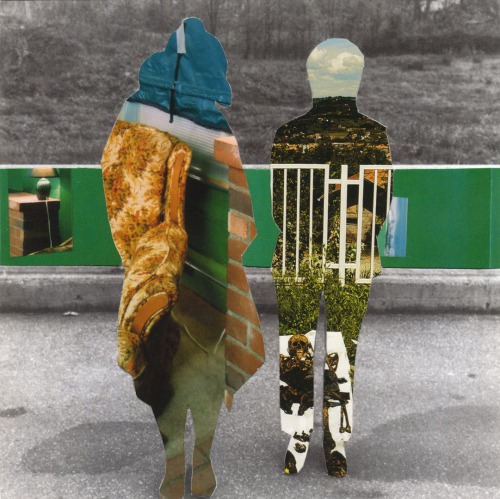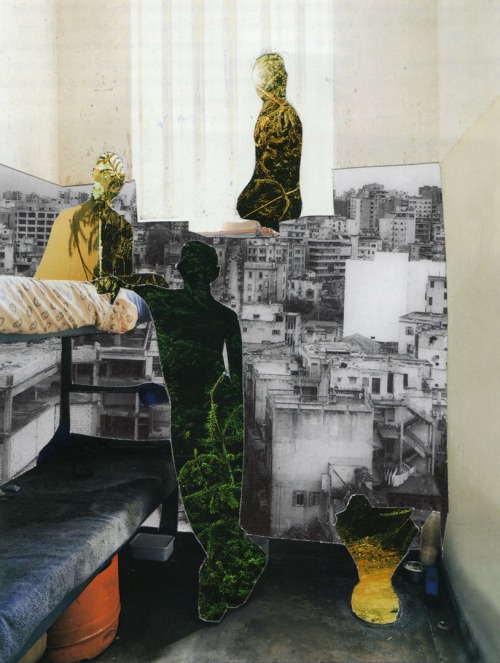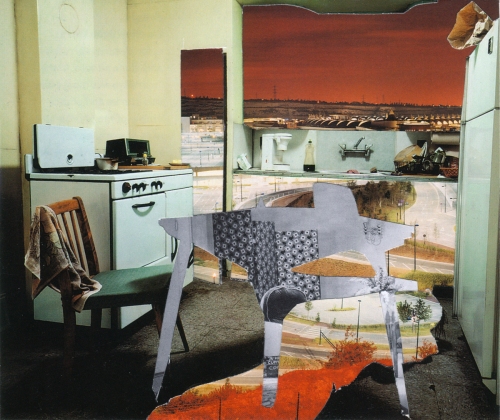Melinda Gibson
by nathandowningsolent
Born in 1985, Melinda Gibson, perched on the cusp of photographic recognition, is the artist responsible for these surreal photomontages. Reincarnated through the slicing and dicing that is appropriation she uses works of art that might be all so familiar to you, maybe even sparking recognition. Utilising pre-existing imagery, cut from the pages of Charlotte Cotton’s book “The Photograph as Contemporary Art”. Photographs from the likes of Edward Burtynsky, Wolfgang Tillmans, Juergen Teller and an array of other leading photographers make their way in to the mixing, layering and juxtapositional placement of pattern and colour seen in Gibson’s profound contemporary art pieces.
Using only a fine scalpel and adhesive she reassembles, in a surreal decontextualisation of the original imagery, a playful scrapbook approach that holds a somewhat darker element, a question of the humanistic kind holding a more analytical representation of borrowed imagery. The stark contrast in location, pattern, colour and authorship reforms its existing context and crafts a newly formed aesthetic structure. The notion of appropriation through imagery, holding righteous connotations envisioned by the previous artist, has raised some controversy. But for Melinda Gibson these issues seem to be a desired consequence, asking such questions in her work making no conscious effort to disguise it as her own.
The figures aren’t produced to perfection and some photographs display fraying shards of paper left from the scalpel. The cutting of the original imagery almost seems aggressive and raises more questions regarding the intentions of Melinda Gibson. In my opinion her photographs are contemporary to say the least, requiring a higher level of intellectual understanding. But her work seems more realised with an evident exposure to the developments of the more contemporary art forms, of an avant-garde taste of photographic work, all so relative to the advancement of digital modernity questioned in this artistic example of appropriation.
Fundamentally the rough and rugged look, bringing even further definition to the reincarnation of existing imagery, interrogates photography as a medium, revealing the question of authorship, context history, context reanalysis and the consequences of said experience. This is explored further in Melinda Gibson’s book “The Photograph as Contemporary Art”. Sound familiar? In a clever propagation of the values of her work, where appropriation is evident, she is able to recreate Charlotte Cotton’s work with a complete recontextualisation. Asking even more questions of authorship within an extremely avant-garde setting, almost warranting such artistic fabrication, when reincarnated, to be conceived and accepted as art.
The physical act of cutting and deconstructing Charlotte Cotton’s work is Gibson’s way of delving in to the book, required as reading in her academic studies at London College of Communication. The imagery, as she cut in to the book, was sorted in to different colours, people and locations, in a recontextualised categorising of the content. Unassembling of the book was her way of digestion, in a way different to the academia-orientated method of information decryption practiced when reading within normality. Further questioning authorship and asking for justification and understanding from the magistrate that is critical artistic analysis.
Melinda Gibson as an artist, shows such transparency and free will towards the practice of appropriation, and with its values being not far from an accepted postmodernism, her work seem somewhat familiarly welcome, either through the notion of artistic development, discovery, or the connotative connections made with the pre-existing imagery. Either way, the surreal depictions, relatable to that of a dream state, uses humans figures in a recontextualised and figurative abstraction, unveiling an almost photographic reflection of a cubist painting, but more noticeably present in aesthetic detail and potentially recognisable imagery. Melinda Gibson’s art is a fine example of the use of appropriation and has been so influential to myself within the developing stages of my final project, I am certainly looking forward to creating something myself that questions the boundaries of an artistic medium.
Bibliography:
Bainbridge, s, “Portfolio: Melinda gibson”, British Journal of Photography, Oct, 2011, Vol 158, Iss 7793,
Cotton C, “The Photograph as Contemporary Art”, 2014, 4th ed, Thames & Hudson, London
Foam Online, “Melinda Gibson”, Foam, 2015 [Viewed 12 Feb 2015]
Available at: www.foam.org/photographers/g/gibson,-melinda
Gibson, M, “In Conversation with Melinda Gibson, Charlotte Cotton and Lucy Moore”, Melinda Gibson Youtube Channel, May, 2013, [Viewed 12 Feb 2015] Available at: www.youtube.com/watch?v=Ei3QIhOjRp4
Gibson, M, Schuman, A, “The Photograph as Contemporary Art”, 2012, Self-published



